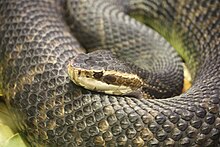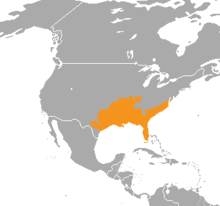Agkistrodon piscivorus
| Agkistrodon piscivorus | |
|---|---|
 |
|
| Scientific classification | |
| Kingdom: | Animalia |
| Phylum: | Chordata |
| Class: | Reptilia |
| Order: | Squamata |
| Suborder: | Serpentes |
| Family: | Viperidae |
| Genus: | Agkistrodon |
| Species: | A. piscivorus |
| Binomial name | |
|
Agkistrodon piscivorus (Lacépède, 1789) |
|
 |
|
| Synonyms | |
|
click to expand
|
|
Agkistrodon piscivorus is a venomous snake, a species of pit viper, found in the southeastern United States. Adults are large and capable of delivering a painful and potentially fatal bite. When antagonized, they will stand their ground by coiling their bodies and displaying their fangs. Although their aggression has been exaggerated, individuals may bite when feeling threatened or being handled. This is the world's only semiaquatic viper, usually found in or near water, particularly in slow-moving and shallow lakes, streams, and marshes. The snake is a strong swimmer and will even enter the sea. It has successfully colonized islands off both the Atlantic and Gulf coasts.
The generic name is derived from the Greek words ancistro (hooked) and odon (tooth), and the specific name comes from the Latin piscis (fish) and voro (to eat); thus, the scientific name translates into “hooked-tooth fish-eater”.Common names include variants on water moccasin, swamp moccasin, black moccasin, cottonmouth, gapper, or simply viper. Many of the common names refer to the threat display, where this species will often stand its ground and gape at an intruder, exposing the white lining of its mouth. Three subspecies are currently recognized, including the nominate subspecies described here.
This is the largest species of the genus Agkistrodon. Adults commonly exceed 80 cm (31 in) in length, females grow up to be smaller than males. Total length, per one study of adults, was 65 to 90 cm (26 to 35 in). Average body mass has been found to be 292.5 to 579.6 g (10.32 to 20.44 oz) in males and 201.1 to 254.1 g (7.09 to 8.96 oz) in females. Occasionally, individuals may exceed 180 cm (71 in) in length, especially in the eastern part of the range.
Although bigger ones have purportedly been seen in the wild, according to Gloyd and Conant (1990), the largest recorded specimen of A. p. piscivorus was 188 cm (74 in) in length, based on a specimen caught in the Dismal Swamp region and given to the Philadelphia Zoological Garden. It should be noted, however, that this snake had apparently been injured during capture, died several days later and was measured when straight and relaxed. Large specimens can be extremely bulky, with the mass of a specimen of approximately 180 cm (71 in) in length known to attain 4.6 kg (10 lb).
...
Wikipedia

